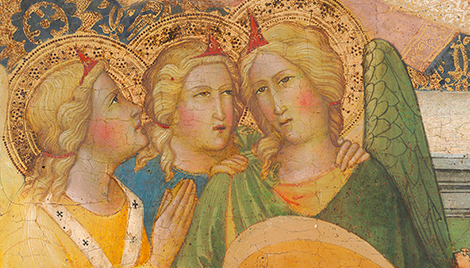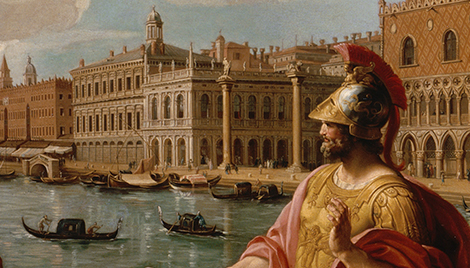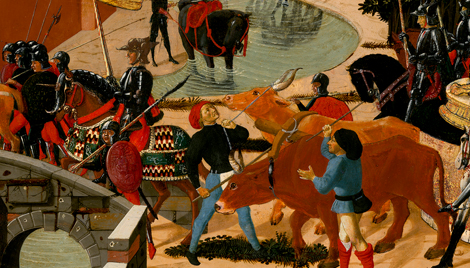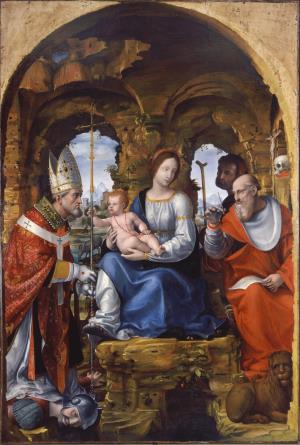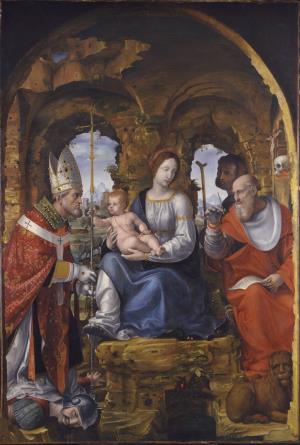Madonna and Child with Saints
Madonna and Child with Saints
- Artist
- Bernardo Zenale
- Artist Dates
- c. 1450/1460-1526
- Artist Nationality
- Italian
- Title
- Madonna and Child with Saints
- Date
- about 1510
- Medium
- oil on panel
- Dimensions
- 181.5 x 123 cm (71-1/2 x 48-1/2 in)
- K Number
- K1626
- Repository
- Denver Art Museum
- Accession Number
- 1961.173
- Notes
Provenance
San Francesco Grande, Cappella della Vittoria, Milan. Crivelli Family, Milan. Edward Solly [1776-1844], London; (sale, Christie’s, London 8 May 1847, no.22 as Leonardo da Vinci); Sir James Domville, England; (sale, Christie’s, London, 30 May 1863, no. 145 as Leonardo da Vinci, bought in); Sir William Domville; (sale, Christie’s, London, 6 March 1897, no. 115 as Leonardo da Vinci); (Thomas Agnew & Sons, London); sold 1907 to Sir Frederick Lucas Cook [1844-1920]; Sir Herbert Frederick Cook [1868-1939], still in 1932; (Count Alessandro Contini Bonacossi [1878-1955] Rome-Florence); sold to Samuel H. Kress [1863-1955] on 10 March 1949; gift 1961 to the Denver Art Museum, no. 1961.173 (on loan from the Kress Foundation, 1954–61).
Catalogue Entry
Bernardo Zenale
Madonna and Child with Saints
K1626
Denver, Colo.,Denver Art Museum (E-IT-18-XVI-944), since 1954.(1)Wood. 71 3/8 x 49 in. (181.5X 124.6 cm.). Good condition except for a few restorations; cleaned 1949-50. Formerly variously attributed to Leonardo, Cesare Magni, the Master of the XL Monogram, and others,(2) K1626 has recently been brought into the oeuvre of Zenale through the convincing attribution to him of the Circumcision in the Louvre inscribed with the monogram XL and the date 1491 (this date is believed not to refer to the execution).(3) Some of the figures in K1626, especially the St. Ambrose, who kneels on a heretic at the left and holds his whip, along with a cross-shaped staff, find close parallels in the Louvre Circumcision and both paintings probably date late in Zenale's career, about 1510. K1626 shows more influence of Leonardo than usual: the composition is strongly reminiscent of the Madonna of the Rocks. A drawing in the Accademia, Venice, is probably an early copy from the painting rather than a sketch for it. The figure at the right, behind St. Jerome, probably represents Joseph. Provenance: Crivelli family, Milan.(4) Edward Solly, London (sold, Christie's, London, May 8, 1847, no. 22, as Leonardo;(5) bought by the following). Sir James Domville (sold, Christie's, London, May 30, 1863, as Leonardo; bought in). Sir William Domville (sold, Christie's, London, Mar. 6, 1897, no 115, as Leonardo; bought by Agnew's). Exhibited in photograph: 'Milanese and Allied Schools of Lombardy,' Burlington Fine Arts Club, London, 1898, as Cesare Magni. Cook Collection, Richmond, Surrey, bought from Agnew's in 1907 (catalogue by T. Borenius, vol. I, 1913, p. 133, no. 114, as Cesare Magni; catalogue by M. W. Brockwell, 1932, p. 108, no. 114, again as Cesare Magni, but as located in Cook house at Studland). Contini Bonacossi, Florence. Kress acquisition, 1949 –exhibited: Philadelphia Museum, 1950-52.(6)
References
(1) Catalogue by W. E. Suida, 1954, p. 48, as Master of the XL Monogram. (2) W. von Seidlitz (in Repertorium für Kunstwissenschaft, vol. XXI, 1898, p.409) and B. Berenson (North Italian Painters, 1907, p. 193; Italian Pictures of the Renaissance, 1932, p. 143; Italian ed., 1936, p. 124) attribute K1626 to Cesare Magni. G. Fogolari (in Rassegna d'Arte Antica e Moderna, vol. I, 1914, p. 32) gives it to Francesco da Milano. R. Longhi (in ms. opinion) attributes it to the Master of the XL Monogram, whom he finds akin to Zenale, the youthful Bramantino, and especially Civerchio. He dates it near the end of the fifteenth century. For other attributions see Provenance, above. (3) See M. Ferrari, in Paragone, no. 127, 1960, pp. 36 ff.; no. 157, 1963, pp. 22 f. Also H. Cook (in Burlington Magazine, vol. IV, 1904, p. 180), some sixty years ago, attributed the Louvre Circumcision to Zenale. The 'XL' inscribed on it is probably not the artist's signature, nor is 1491 the date of the execution. Ferrari (in Paragone, no. 127, 1960, pp. 55 f.) discusses the probability that '1491' refers to an event commemorated by the Louvre painting. (4) Descriptive Catalogue of the Collection of Italian Pictures of the Rafaelle Period of the Late Edward Solly, Esq., n.d., no. XXVI, as Leonardo and as coming from the Crivelli family of Milan. (5) Ibid. (6) Catalogue by Suida in Philadelphia Museum Bulletin, vol. XLVI, Autumn, 1950, as Master of the XL Monogram.

